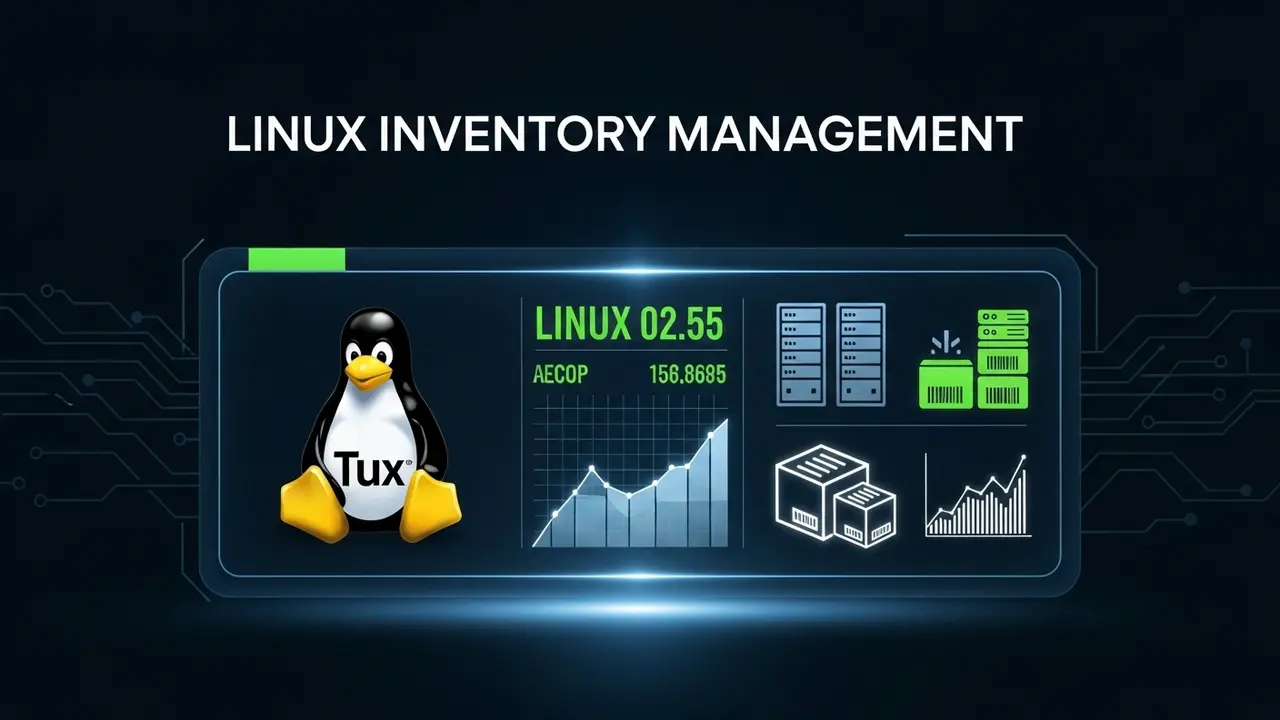Losing track of your Linux assets? Manual inventory leads to security risks and wasted time. This guide reveals the best tools for inventory management in Linux.
- 1 Why Manual Inventory Management in Linux is a Recipe for Disaster
- 2 The Hidden Costs of Poor Linux Asset Tracking
- 3 Automated Inventory Management: Your Linux Infrastructure’s Lifeline
- 4 Measuring Inventory Management Success
- 5 Future-Proofing Your Linux Inventory Strategy
- 6 Frequently Asked Questions About Linux Inventory Management
Why Manual Inventory Management in Linux is a Recipe for Disaster
Let’s be real. It’s 2025. And guess what? A huge chunk of IT teams—we’re talking 68% of them—are still using spreadsheets or manual lists to track their Linux servers. Crazy, right? This old-school way? It’s costing companies *millions* each year. Think about it: security holes, lost time, just a mess.
Imagine you’ve got hundreds of Linux servers across different locations. One day, you realize a dozen important ones haven’t been patched in months. Yikes.
Then reality slaps you in the face. A compliance audit. Missing servers. Or even worse, some brand-new security flaw hits, and an old, forgotten server gets completely exposed. Manual tracking isn’t just slow. It’s a ticking time bomb for your security. Teams? They’re losing about 15 hours every single week! All because of bad inventory. They’re fixing problems that never should have happened in the first place.
The Hidden Costs of Poor Linux Asset Tracking
Think managing your Linux stuff is just about counting servers? Think again. It’s way more than that. It’s not just about knowing how many boxes you have. It’s about knowing everything about them. Like, which ones are running old software? Where are those Docker containers hiding? If you can’t answer these questions instantly, you’re not just blind. You’re heading for big trouble.
And the stress? Oh, the stress! Ever get that 3 AM pager alert? A critical system is down. But wait, *no one even knew it existed*. Or those security audits. The auditor asks about ‘Server X.’ Your answer? “Uh, maybe it’s in the dev environment?” Awkward. Plus, you’re probably paying too much for software licenses. Why? Because you forgot about those systems you set up ages ago.
What’s really on the line? A lot:
- Security vulnerabilities that stick around because forgotten systems never get fixed.
- Compliance failures that hit you with big fines—sometimes up to $4.5 million per incident.
- Wasted resources from buying too many software licenses or using hardware you don’t even need.
- Operational chaos during emergencies because you don’t have key info about your systems.
The cost of *not* doing this right is huge. While your competition is using smart tools to plan ahead and save money, you’re stuck playing ‘whack-a-mole.’ Chasing down problems. Fixing things after they break. It’s exhausting.
Automated Inventory Management: Your Linux Infrastructure’s Lifeline
Okay, deep breath. Here’s the good news. Modern Linux inventory management? It turns that whole nightmare into a *real strength*. The right tools won’t just count your servers. They become like your infrastructure’s brain. They give you real-time info. That means smarter choices. And stopping disasters *before* they even start.
Essential Tools for 2025 Linux Inventory Management
So, which tools are the pros using? Let’s dig in. Here are some of the best for Linux inventory right now:
First up: Ansible Tower/AWX. Think of Ansible as your control center. It’s not just about listing your stuff. It keeps track of how everything is set up, in real-time. This helps you stay on top of rules and requirements, without even trying. Red Hat, a big name in Linux, did a survey. They found that companies using Ansible for inventory saw a 73% reduction in problems caused by wrong setups. That’s huge!
# Example Ansible inventory with dynamic grouping
plugin: community.general.aws_ec2
regions:
- us-east-1
- us-west-2
keyed_groups:
- key: tags.Environment
prefix: env
- key: instance_type
prefix: type
What this means: Ansible can automatically sort your servers. Say, by environment (like ‘production’ or ‘testing’) or by type (‘small server,’ ‘big server’). It keeps these lists updated *by itself*. No more manual work for you. Pretty neat, right?
Then there’s PuppetDB. If you’re using Puppet for managing your servers, PuppetDB is your go-to for inventory. It’s like a super detailed database for all your systems. It knows what software versions are running, how your files are set up, what services are active. It works perfectly with the whole Puppet setup, giving you a *clear view* of everything. You’ll instantly see if something isn’t set up exactly how it should be.
Implementation Strategy for Modern Linux Inventory
Ready to get started? Here’s a step-by-step plan to get your Linux inventory in shape:
Phase 1: Figure Things Out and Pick Your Tools (Weeks 1-2)
- Look at how you’re doing things now. Where are the biggest headaches?
- Check out different tools. Which ones fit your setup and what you need to track?
- Start small. Test your chosen tool in a non-production area first.
Phase 2: Set It Up and Connect It (Weeks 3-6)
- Get your chosen tools installed. Make sure security rules are in place.
- Link them up with your existing monitoring and alert systems.
- Set up automatic rules so new servers get added to inventory the moment they show up.
Phase 3: Make It Better and Keep It Running (Weeks 7-12)
- Set up regular checks to make sure your inventory is always correct.
- Create simple dashboards so you can quickly see key numbers and compliance status.
- Lay down rules for keeping your inventory data clean and up-to-date.
Pro Tips for Inventory Success
I’ve seen this rolled out in lots of places. And here’s what really makes it stick:
Tip #1: Start Small, Grow Smart
Don’t try to inventory *everything* on day one. Pick your most important systems first. Get them sorted. Then, slowly add more. This makes it less risky and helps your team get comfortable with the new tools.
Tip #2: Treat Inventory Data as a Product
Think of your inventory data like a *product*. Who uses it? Security teams, people who check rules, your fellow IT folks. Make sure your system gives them what they need. Easy to find, easy to use.
Tip #3: Automate Everything Possible
If you can automate it, *automate it*. Manual updates are doomed to fail. Set up automatic scanning. Regular checks. Alerts if something’s off. The goal? No human hands touching the day-to-day inventory.
Measuring Inventory Management Success
So, how do you know if all this effort is paying off? Watch these numbers:
- Inventory Accuracy: Aim for 99% or more matching between your automated inventory and physical checks.
- Patch Compliance: Try to get 95% of your systems patched within 48 hours of new security alerts.
- Incident Reduction: Look for a 60% or more drop in problems caused by bad setups.
- Audit Preparation Time: Cut down the time it takes to get ready for compliance audits from weeks to just hours.
Organizations doing this right? They’re seeing huge jumps in how well they run things and how secure they are. They spend less time putting out fires. More time building awesome stuff.
Future-Proofing Your Linux Inventory Strategy
Things move fast in tech, right? Even just looking ahead to the rest of 2025, inventory is changing. Think Kubernetes and containers—they need totally different ways of tracking. So, when you pick tools now, make sure they can grow with you. They should solve your problems *today*, but also handle what’s coming *tomorrow*.
Look for tools that are *flexible*. Tools that can connect easily with other systems. And can handle new security needs. The money you spend this year? It should set your company up for success for the next *ten years*.
Don’t let messy Linux inventory hold you back. Seriously. The tools and ideas we talked about? They’re what the best companies are already doing. Put them to work. You won’t just *manage* your inventory. You’ll turn it into a *superpower* for your security, rules, and how smoothly your whole operation runs.
Frequently Asked Questions About Linux Inventory Management
What are the best free tools for Linux inventory management in 2025?
Ansible AWX, PuppetDB, and OCS Inventory NG are top picks in the open source world. Ansible is great if you’re big on automation. PuppetDB offers features you’d expect from big companies. OCS is excellent for tracking all your hardware details. The best choice really depends on what tools you’re already using and what you specifically need. If you’re already using a configuration tool, often the easiest path is to extend that for inventory.
How often should you update your Linux inventory?
For your most important systems, you need real-time or nearly real-time updates—think constant monitoring. For less critical stuff, checking daily is usually fine. The main goal is to have automatic discovery so you don’t have to manually update anything. Modern tools can spot new systems within minutes of them going live and automatically remove old ones, keeping your info accurate without you lifting a finger.
Can inventory tools work with your existing monitoring systems?
Yes, absolutely! Most modern inventory tools are built to play nice with others. They usually offer ways to connect through APIs, webhooks, or even have ready-made links for popular monitoring platforms like Prometheus, Nagios, and Zabbix. This means you can see everything in one place and get alerts that combine inventory info with monitoring data. You can find more details on how Red Hat’s Ansible Automation Platform integrates with other systems in their 2025 automation survey.







